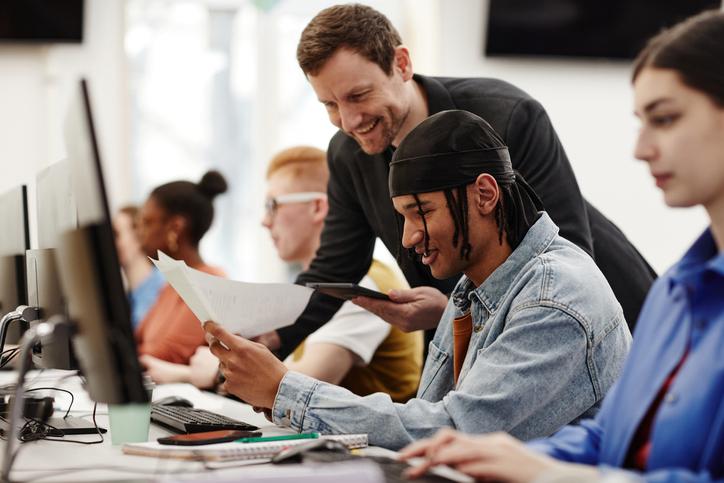
Co-creation as a liberating activity

Education is dealing with the sudden appearance of a massive monkey wrench in its works called generative artificial intelligence (AI). And while we attempt to meld that wrench with the machinery, one thing we might agree on is that a focus on the process of learning over the product is a promising way to move forward. You can’t lie on the couch watching Sweatin’ to the Oldies and expect to get fitter, right? How better to ensure learners get up and sweat with us than to invite them into the learning process?
Enter student co-creation.
- Teaching originality: an essential skill in the age of ChatGPT
- Active learning strategies to boost student engagement
- Spotlight guide: The practicalities of co-creation with students
Student co-creation is an approach that empowers learners to actively participate and collaborate in the learning spaces where they find themselves. By involving students as partners in learning and teaching, educators can foster a more engaging, inclusive and student-centred educational experience. Drawing insights from influential resources in the field, and the practical experience gained from using student co-creation heartily in the creation of the award-winning Liberated Learners programme, this article explores best practices for student co-creation in education and offers practical advice for educators.
Student co-creation and generative AI
Generative AI tools such as ChatGPT have thrust a test of our moral fibre in between us and virtually every traditional written task we face. Shall I think for myself and work this through? Or shall I have the ol’ AI write me something passable and throw it into the drop box? Sometimes it’s tempting. OK, OK – it’s always tempting.
Generative AI is not going away, and the practice of student co-creation isn’t the antidote to it. In fact, it is very likely that learners can and will use something like ChatGPT in student co-creation activities. The biggest shift here is that learners are invited in and actively involved in the process of teaching and learning, rather than simply being receivers of learning content. And that just might nudge learners to lean into the work. We will offer key differences in learning steeped in co-design over a more traditional, transactional learning space and include practical lessons learned in using co-design in the creation of the Liberated Learners programme.
Co-creation surprises students with respect
Creating a culture that values and promotes student-faculty collaboration is crucial. As a start, educators can acknowledge students as partners and equal contributors to the learning process. Alison Cook-Sather, Catherine Bovill and Peter Felten list respect as their first guiding principle in their 2014 guide Engaging Students as Partners in Learning and Teaching.
In the Liberated Learners project, the seven partner institutions each enlisted student co-designers. These were student multimedia, graphic and instructional designers. This, we believe, gave the learners the clear indication that they were true partners in the work, and this was a happy surprise to some. Encourage open communication, mutual respect and shared decision-making between students and faculty.
Co-creation engages students in designing a curriculum that is engaging
Involving students can ensure learning spaces reflect their diverse needs, interests and aspirations. Students can provide valuable input in shaping the learning outcomes, content and assessment methods. Lucy Mercer-Mapstone and co-authors from the University of Queensland and Trinity, Elon and McMaster universities describe “the need to move toward inclusive, partnered learning communities in higher education” as a key theme in students as partners scholarship.
In the Liberated Learners project, student co-designers facilitated a design sprint in which other learners told us the stories of problems and difficulties they faced in their learning journeys. Those stories were then used as the basis for the curriculum of the resource itself. This practice encourages co-ownership of the educational experience.
Co-creation empowers students to tell you how they want to learn
Incorporating student involvement in the assessment process – and so moving beyond traditional models – empowers students to be their full selves in their work. Elisabeth Dunne, from the University of Exeter, and co-authors have claimed that “the more that students are encouraged to be independent and creative, the more surprising and exciting will be the outcomes”. Instead of requiring an essay, for instance, you might get handed quirky, unique and joyful comic books, ’zines or podcasts. Fun!
Our Liberated Learners student partners designed activities and resources such as the Positionality Tree, Empathy Maps, Fan Posters, the Takeout Menu and the Game of School. I’d wager those all sound more fun than 99 per cent of the schoolwork you ever did. This approach promotes metacognition, critical thinking and active engagement. It also strengthens students’ sense of agency and responsibility for their own learning. Those are very good things.
Co-creation helps us redesign learning spaces into ones learners might feel comfortable in
This is an opportunity to rethink the physical and virtual learning environments to facilitate student co-creation. Preparing minimalistic, flexible spaces that encourage collaboration, communication and creativity can provide room for your learners to leave their own lasting marks. Consider incorporating technology that enables collaborative project work and knowledge sharing.
In Liberated Learners, we had smaller module teams work away on templated collaborative docs that were accessible to all the teams, with plenty of commenting and discussion in our weekly open meetings. By providing conducive spaces, institutions can support students in their co-creation endeavours.
Co-creation can transform the learning experience
Student co-creation in education can transform the learning experience and empower learners. By working to foster a culture of partnership, involve students in curriculum design and redesign learning spaces, educators and institutions can create an environment where students actively contribute to their own learning. Heck, they might even enjoy the experience and think back upon it fondly. It is crucial to adapt and refine these practices based on ongoing research, collaboration and feedback from students, enabling continuous improvement in student co-creation efforts.
Terry Greene is a senior e-learning designer at Trent University, Ontario, Canada.
Liberated Learners won the 2022 Open Education Global Award for best open education resource.
If you would like advice and insight from academics and university staff delivered direct to your inbox each week, sign up for the Campus newsletter.


